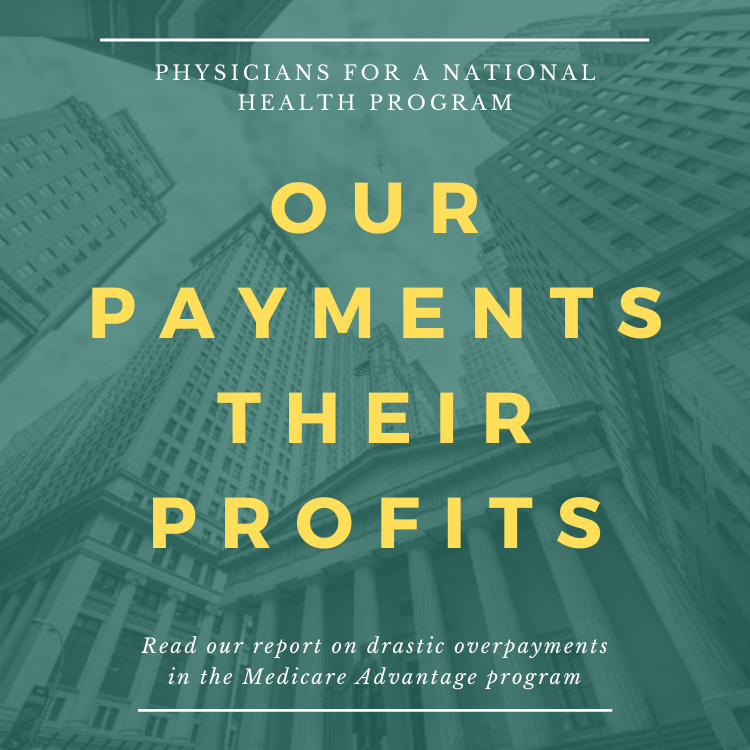Hillary Clinton Takes a Step to the Left on Health Care
By Alan Rappeport and Margot Sanger-Katz
The New York Times, May 10, 2016
Mrs. Clinton is moving to the left on health care and this week took a significant step in her opponent’s direction, suggesting she would like to give people the option to buy into Medicare.
“I’m also in favor of what’s called the public option, so that people can buy into Medicare at a certain age,” Mrs. Clinton said on Monday at a campaign event in Virginia.
Mrs. Clinton’s suggestion was that perhaps younger Americans, “people 55 or 50 and up,” could voluntarily pay to join the program.
Mr. Sanders calls his single-payer health care plan “Medicare for all.” What Mrs. Clinton proposed was a sort of Medicare for more.
http://www.nytimes.com/2016/05/11/us/politics/hillary-clinton-health-care-public-option.html
***
Comment:
By Don McCanne, M.D.
Hillary Clinton is once again bringing back the proposal to allow for people under 65 to have the option of purchasing coverage under Medicare – the so-called public option. We have written much about this in the past, but since her comments have renewed enthusiasm amongst single-payer advocates for a Medicare buy-in, let’s discuss it one more time.
First of all, without additional coverage such as Medigap plans, the traditional Medicare program leaves individuals potentially exposed to significant costs. It does not even have a catastrophic cap on coverage. Would an individual opting for a Medicare buy-in need to also purchase a Medigap plan? Or would a special Medicare plan be offered that included those benefits?
How would the premium for a Medicare buy-in be determined? Would it be based on the current Medicare risk pool that includes the elderly with all of their chronic disorders and end-of-life care, plus the high costs of Medicare beneficiaries with long term disabilities or end stage renal disease? That alone would price the Medicare buy-in out of the market. Would a separate risk pool be established – one that likely would be subject to adverse selection?
The public option was included in the House version of the Affordable Care Act (Affordable Health Care for America Act), but when these issues were faced it did not end up resembling Medicare. It became simply another plan similar to private plans but with even greater restrictions in order to prevent the insurers from having to face “unfair competition” from the public plan. In the Senate version, which was the version that eventually became law, Sen. Lieberman was successful in having the public option stripped out of the bill. But had it been left in, it would have been an unsatisfactory program. Think of how Congress set up the co-ops to fail, again simply to protect the private insurers from competition. The lessons of the co-ops provide lessons for the public option.
Also Congress is a force to reckon with. Medicare needs many improvements, but instead Congress continues to nurture the private Medicare Advantage (MA) plans while neglecting the traditional Medicare program. The Medicare improvements in the Affordable Care Act (ACA) were negligible compared to the need. It is difficult to see Congress enacting a Medicare public option that has better benefits and lower costs than the private MA plans – certainly not as long as the private insurance industry holds sway over Congress.
Further, the public option fails to capture most of the efficiencies and savings of the single payer model. The public option would be only one more player in our wasteful, administratively-complex, fragmented system of financing care. Even the current Medicare program, as large as it is, is unable to revise the fragmented financing infrastructure that permeates the rest of the health care system and is responsible for so much of our waste. Adding the public option to the individual insurance market could not have more than a negligible impact.
Okay, let’s fantasize and pretend that we have a Congress and administration that really wants to enact a Medicare buy-in. Let’s pretend that they improve the benefits, though that would cause an increase in the premiums. Let’s pretend that they could put together a package that would compete with private plans, though that would result in greater administrative costs than we already have with Medicare. Let’s pretend that they would offer the same premium subsidies and tax credits that are currently offered for private plans in the exchanges. You would still have a relatively small impact on the market since most individuals would still be covered through employer-sponsored plans, Medicare, Medicaid, the VA, and other programs.
Let’s suppose that employers finally decide to eliminate their plans. At present, it appears that they would likely refer their employees to private insurance exchanges, which do not happen to be eligible for the credits and subsidies and likely would remain that way unless the government were to take over the private exchanges. Can you imagine the public response to the government nationalizing private exchanges?
If you read the Physicians’ Proposal again, you would find that most of the advantages of a single payer system will not have been enacted even with a well designed Medicare public option.
No, a Medicare buy-in or public option is not a step towards single payer. It would be merely another player in our dysfunctional system. Worse, it would further postpone enactment of the reform that we really need merely because we would be thinking that we’ve done something when we really haven’t.
Sorry, but we have to change that chant from “Public Option” to “Medicare for All, not just some.”
